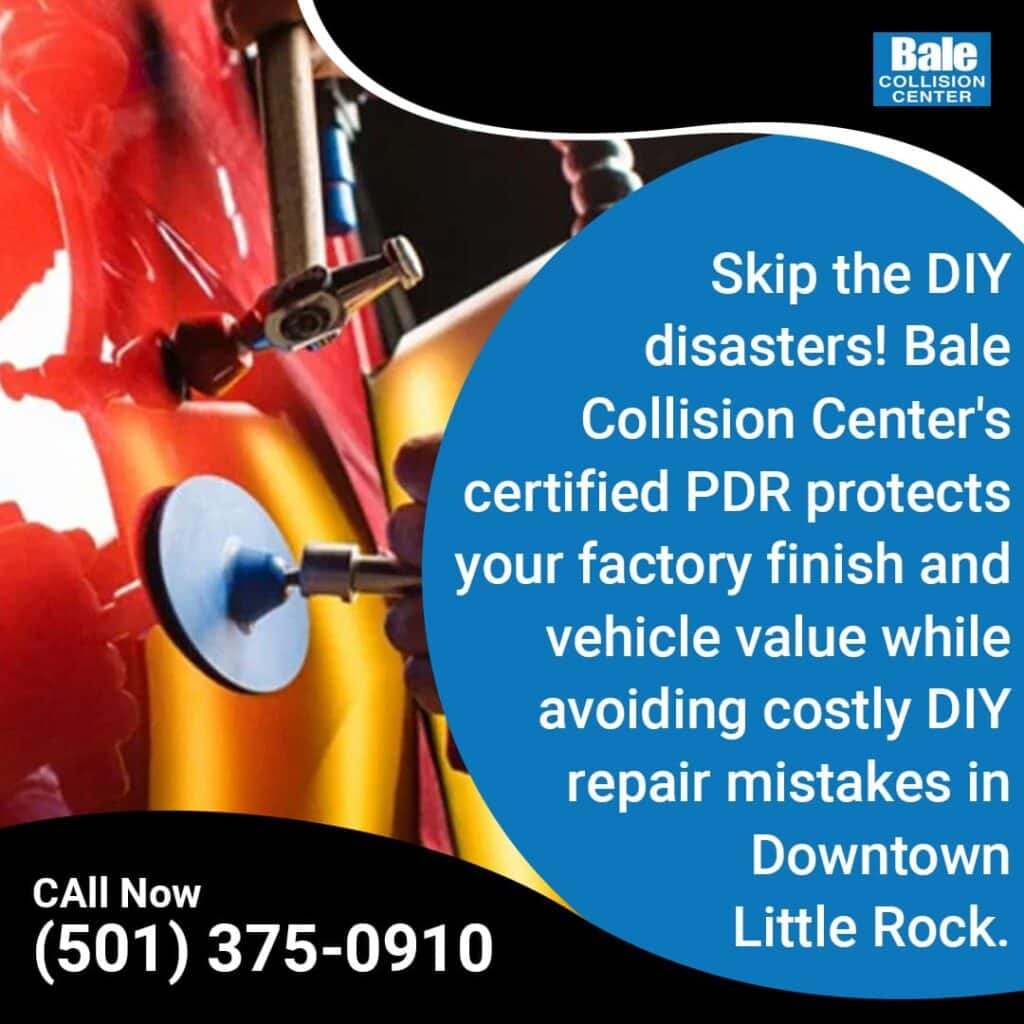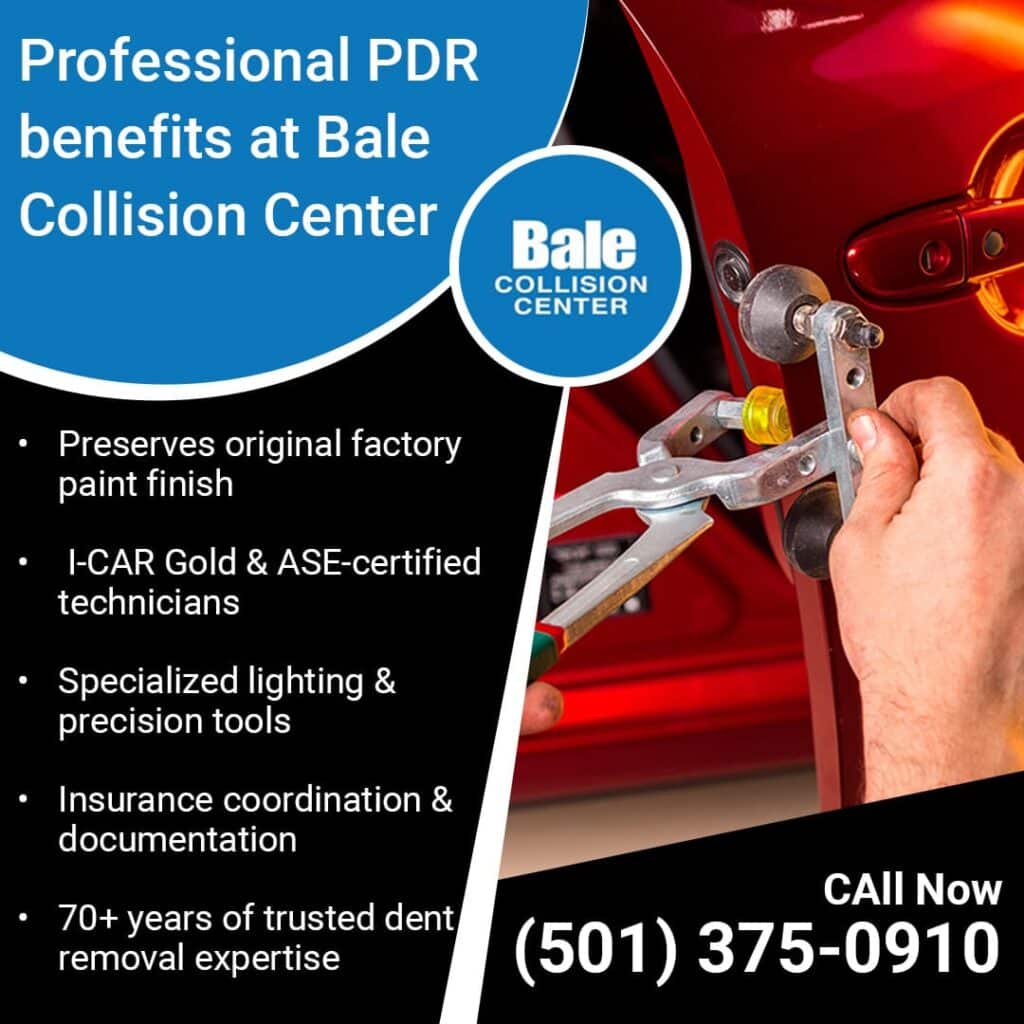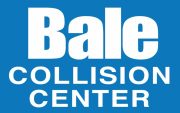DIY dent repair kits promise quick, affordable fixes for vehicle damage, but these products often create more problems than they solve. Professional paintless dent repair requires specialized training, proper equipment, and years of experience to execute safely. Attempting PDR without these qualifications can result in paint damage, stretched metal, insurance complications, and repairs that exceed the original dent’s scope.
Vehicle owners in Little Rock, Arkansas, face regular challenges from parking lot incidents, hailstorms, and minor collisions that create frustrating dents and dings. The temptation to purchase an inexpensive DIY kit and tackle the repair yourself becomes strong when facing repair estimates. However, understanding the risks and limitations of these products can save substantial money and prevent permanent vehicle damage.
At Bale Collision Center (Downtown), our I-CAR Platinum-certified technicians have seen numerous vehicles damaged by DIY repair attempts. What begins as a simple dent often becomes a complex restoration requiring traditional bodywork, paint matching, and panel replacement. This blog examines why professional paintless dent repair delivers superior results while DIY kits can cause expensive complications.

The Appeal of DIY Dent Repair Solutions
The marketing behind DIY dent repair kits creates compelling arguments for attempting home repairs.
Marketing Promises vs Reality
DIY kits typically retail at attractive price points compared to professional dent removal services. Marketing materials emphasize immediate savings without disclosing potential failure rates or limitations. This price comparison ignores the substantial risk of creating damage that requires expensive professional correction.
The actual analysis becomes more complex when considering success rates and potential complications. Failed DIY attempts often require extensive repairs that exceed the original professional estimate by substantial margins.
Convenience Factor Appeals to Busy Schedules
Home repair eliminates scheduling appointments, transportation arrangements, and time without the vehicle. DIY kits allow repairs at your convenience without coordinating with service providers or adjusting work schedules. However, this convenience disappears when repairs fail or create additional damage.
Simple Marketing Claims
Kit manufacturers present PDR as straightforward, requiring only basic tools and common sense. Video demonstrations show seemingly effortless repairs using household items and simple techniques. These presentations omit the extensive training and experience required for consistent success.
Marketing materials typically feature best-case scenarios using shallow, accessible dents on flat panels. Real-world damage scenarios involving complex curves, difficult access points, or stressed metal require professional expertise that DIY kits cannot provide.
Common DIY Dent Repair Failures
Multiple technical and practical factors contribute to high DIY failure rates in paintless dent repair across Downtown Little Rock and the surrounding areas.
Lack of Proper Training Requirements
Professional PDR technicians complete extensive training programs lasting 40-120 hours with certified instructors. These programs teach specialized techniques, tool usage, metal properties, and damage assessment that take time to master. DIY kit instructions cannot replicate this education.
I-CAR certification requires ongoing education to maintain current knowledge of evolving repair methods and vehicle technologies. Reputable technicians complete formal training programs and maintain certifications from recognized organizations. This professional development helps technicians understand modern vehicle construction, paint systems, and safety requirements.
At Bale Collision Center, our technicians maintain I-CAR Platinum certification and ASE certification, representing the industry’s highest training standards. This certified PDR expertise enables proper damage assessment and technique selection that DIY attempts cannot match.
Inadequate Equipment Limitations
Professional car dent removal requires specialized tools, including precision rods, specialized lighting systems, and calibrated measurement equipment. DIY kits provide basic tools that lack the precision and variety needed for effective repairs.
Professional lighting systems reveal damage characteristics invisible under standard lighting conditions. Every PDR process incorporates specialized lighting. This equipment enables technicians to assess damage accurately and monitor repair progress.
Tool selection varies based on dent location, metal thickness, paint type, and access limitations. Professional technicians maintain extensive tool collections acquired over years of experience. DIY kits cannot provide this variety or quality level.
Metal Properties and Paint System Challenges
Modern vehicles use various metal types, including high-strength steel, aluminum, and composite materials. Each material requires different techniques and force applications. DIY repair attempts often apply excessive force or incorrect techniques that stretch metal beyond repair limits.
Paint flexibility varies between manufacturers, vehicle ages, and environmental exposure. Attempting DIY dent repair can often lead to more damage with irreversible consequences, causing cars to begin rusting. Professional technicians assess paint condition before attempting repairs to prevent cracking or lifting.
Factory paint finishes contain multiple layers requiring specific temperature and humidity conditions during repair. DIY attempts under uncontrolled environments can compromise paint integrity and create permanent damage.
Hidden Consequences of Failed DIY Attempts
Failed DIY repair attempts create multiple financial and practical complications beyond the original repair scope.
Paint Damage and Refinishing Requirements
DIY dent repair mistakes can result in paint damage, stretched metal, and surface imperfections that require traditional bodywork and refinishing. Paint matching modern vehicles requires specialized equipment and materials not available for DIY repairs.
Color matching involves computer analysis, paint mixing, and application techniques that create seamless blends. Failed DIY attempts often require complete panel refinishing rather than localized repairs, substantially increasing repair scope.
Clear coat damage from DIY tools requires professional correction to prevent oxidation and further deterioration. This damage often extends beyond the original dent area, creating larger repair requirements that affect vehicle appearance and value.
Insurance Coverage Complications
Insurance companies classify additional damage from DIY repair attempts as separate incidents rather than part of the original claim. When your vehicle sustains damage, that’s considered one event for insurance purposes. Additional damage from DIY repair attempts gets treated as separate, pre-existing damage that may not receive coverage.
This classification creates situations where original damage becomes uninsurable after DIY repair attempts. Professional appraisers can identify DIY repair attempts and may exclude related damage from coverage, leaving vehicle owners responsible for extensive repair bills. Coverage policies may not apply to self-inflicted damage from DIY repair failures. This exclusion can result in complete claim denial for extensive damage caused by improper repair attempts.
Vehicle Value Impact
Professional appraisers and potential buyers can identify previous DIY repair attempts through paint inconsistencies, metal irregularities, and tool marks. These indicators reduce vehicle resale and trade-in values substantially.
CarFax reporting may include accident history when DIY repairs require professional correction. This reporting affects vehicle marketability and financing options for future buyers, creating long-term financial consequences.
Quality paintless dent repair preserves the factory paint finish and maintains vehicle value. DIY attempts that require refinishing eliminate this benefit and create a permanent value reduction that affects ownership experience.
Professional vs DIY Repair Outcomes
The difference between professional paintless dent repair and DIY attempts becomes clear when examining real-world results and long-term consequences.
Professional Expertise Delivers Consistent Results
The experience of professional PDR technicians enables accurate assessment of repair feasibility and selection of appropriate techniques for each specific situation. Certified PDR specialists understand how different metals respond to repair techniques and can identify potential complications before they occur. This knowledge prevents damage escalation and maintains vehicle integrity throughout the restoration process.
Professional facilities maintain controlled environments that eliminate variables affecting repair quality. Proper lighting, temperature control, and specialized equipment create conditions necessary for precision work that DIY settings cannot replicate.
Long-term Vehicle Protection
Quality professional repairs preserve factory paint finish and maintain vehicle structural integrity. This preservation protects your investment while maintaining appearance standards that reflect proper vehicle care and maintenance.
Professional documentation provides service records that demonstrate proper repair methods and materials. These records support warranty claims and maintain vehicle history that affects resale value and future service requirements.
Vehicle Damage Types Requiring Professional Attention
Certain damage characteristics and vehicle conditions make DIY repair attempts particularly dangerous and likely to fail completely.
Complex Damage Scenarios
Deep, angular dents or damage along the edges of bodywork cannot be repaired with DIY methods. These damage types require professional assessment and specialized techniques for proper restoration without creating additional problems.
Crease damage involves metal stretching that DIY tools cannot address effectively. Attempting repair on creased metal often creates additional damage requiring extensive professional correction and traditional bodywork methods.
Multiple impact areas require coordinated repair techniques and professional judgment about repair sequencing. DIY attempts on complex damage typically worsen problems and create expensive complications that affect multiple vehicle systems.
Paint System Considerations
Any visible paint damage eliminates DIY repair viability and requires professional refinishing work. Paint chips, scratches, or clear coat damage will worsen with DIY repair attempts and create permanent appearance issues.
Older vehicles with brittle paint systems risk extensive damage from DIY repair tools. Professional assessment can identify paint condition limitations before attempting repair and recommend appropriate restoration methods.
Specialty paint finishes, including metallics, pearls, or multi-stage systems, require professional color matching and application techniques. DIY attempts on specialty finishes typically result in complete panel refinishing requirements and substantial repair expansion.
Vehicle-Specific Challenges
Luxury vehicles often use aluminum panels requiring specialized tools and techniques not available in DIY kits. Professional aluminum repair prevents expensive panel replacement requirements and maintains vehicle integrity.
Electric vehicles present unique challenges, including battery placement, sensor locations, and manufacturer-specific repair requirements. DIY attempts may damage safety systems or void warranties, creating liability and financial consequences.
Lease vehicles require professional documentation and warranty-approved repair methods. DIY repairs may violate lease agreements and create financial penalties at vehicle return, affecting overall ownership experience.

Bale Collision Center: Quality Dent Removal Services in Downtown Little Rock
Bale Collision Center provides professional car dent removal in Downtown Little Rock, Arkansas, that delivers consistent results while protecting vehicle value and avoiding DIY complications.
Certified Technician Expertise
Our shop maintains I-CAR Gold certification and ASE certification, representing the industry’s highest training standards for auto body and collision repairs. Our technicians complete ongoing education to stay current with evolving repair methods and vehicle technologies.
Our certified team understands vehicle construction, paint systems, and safety requirements that maintain proper repair execution. This expertise enables accurate damage assessment and appropriate technique selection for superior results across all vehicle types.
We follow OEM repair procedures and material requirements to restore vehicles properly, regardless of make or model. This commitment maintains repairs that meet safety standards and preserve vehicle integrity for long-term ownership satisfaction.
Advanced Equipment and Facilities
Our certified PDR services utilize specialized tools, lighting systems, and controlled work environments that enable precision repairs. This equipment investment provides consistency and quality impossible with DIY approaches or mobile dent removal services.
We maintain both PDR and conventional repair capabilities under one roof, allowing seamless transition between repair methods when damage exceeds PDR limitations. This approach provides appropriate solutions for every damage type without referral delays.
Advanced diagnostic equipment enables thorough damage assessment and proper repair completion verification. This technology separates professional operations from basic dent removal services and maintains quality standards throughout the restoration process.
Insurance Coordination Experience
We maintain established relationships with major insurance companies. These partnerships streamline claims processing for car dent removal in Downtown Little Rock, Arkansas. Our team provides regular communication throughout repair processes, keeping customers informed about progress and completion timelines.
Quality assurance protocols verify every repair meets our standards and industry best practices before vehicle delivery. Our controlled environment eliminates variables that compromise repair quality in uncontrolled settings or temporary locations.
Complete Service Experience
At Bale Collision Center, we handle damage assessment, insurance coordination, repair execution, and quality verification as one seamless service. This approach eliminates complications while maintaining proper restoration standards throughout the process.
Our 72 years of Arkansas service provide deep community connections and an established reputation for quality workmanship. This experience enables confident handling of any dent repair challenge in Downtown Little Rock and the surrounding communities.
We provide realistic timeframe estimates and work efficiently to minimize vehicle downtime while maintaining quality standards. Our systematic approach reduces disruption compared to multiple DIY repair attempts that often create additional problems.
Choose Certified PDR in Downtown Little Rock, Arkansas for Reliable Results
DIY dent repair kits promise easy solutions, but can create expensive complications that exceed the original repair scope. Professional paintless dent repair protects your vehicle investment while maintaining quality restoration that preserves appearance and value.
Bale Collision Center combines decades of experience with modern equipment and certified expertise to deliver superior dent removal services in Downtown Little Rock. Our I-CAR Gold and ASE-certified technicians use proven techniques that avoid DIY pitfalls while providing reliable, lasting results.
Call Bale Collision Center at (501) 375-0910 or email bccdowntown@baleautomotive.com for professional car dent removal in Downtown Little Rock, Arkansas. Get your vehicle restored right the first time with our certified PDR specialists.
